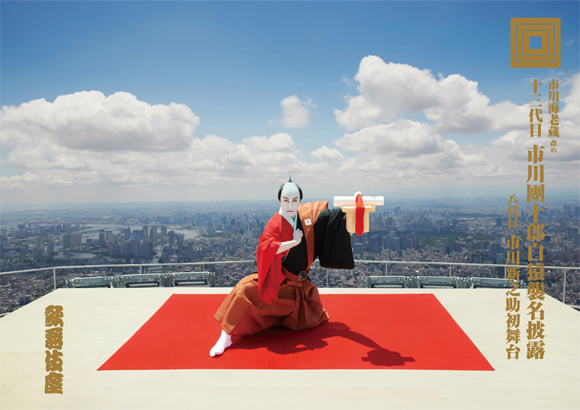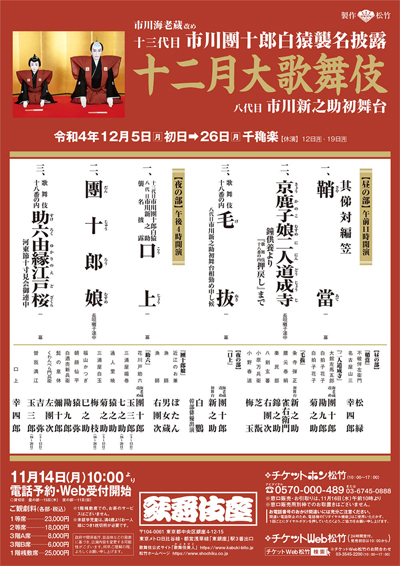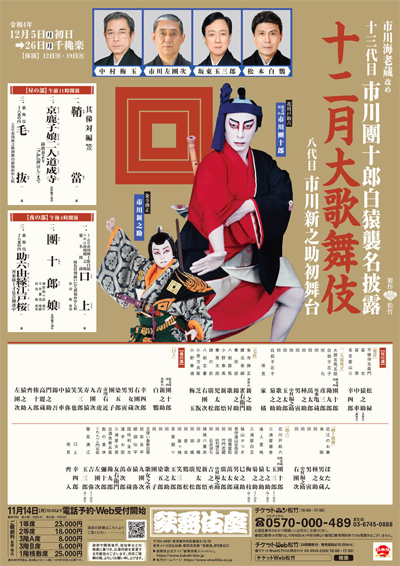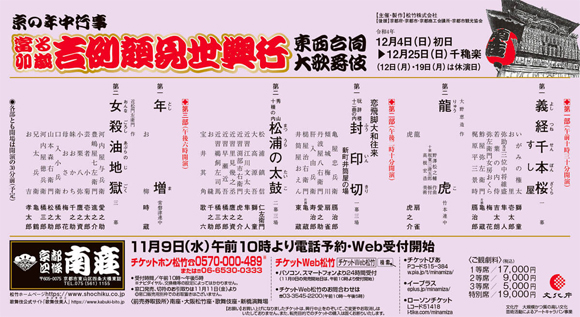| Comments |
The traditional kaomise in Ky˘to at the Minamiza.
Sushiya: this is one act of an epic originally written for the
Bunraku puppet theatre. The full-length play shows the fate of various
Taira generals in hiding after the victory of their enemy, the Genji.
In this act, Koremori (Nakamura Hayato ), the heir to the Taira clan is hiding
in a sushi shop disguised as
a humble apprentice, and Osato (Nakamura Kazutar˘),
the daughter of the house, falls in love with him. However, Gonta (Nakamura Shid˘),
the evil son of the house plots to gain a reward by turning in
Koremori to the top Genji general Kajiwara (Nakamura Ganjir˘), but in the end,
he has a surprising change of heart in one of the most heart-rending scenes
in Kabuki. Also featuring Kataoka Kamez˘ as Yazaemon, the proprietor of the sushi shop.
Ryűko: this is a modern piece created after the end of World War II
on the universal theme of the unending fight between the dragon, the greatest power in the sky,
and the tiger, the greatest power on land. Starring Nakamura Senjaku as the spirit of the dragon and
Nakamura Senjaku's son Nakamura Toranosuke as the spirit of the tiger (tora means ... tiger in Japanese).
Fűin Giri:
(Breaking the Seals)
In the pleasure quarters, the most important possessions
were money and reputation. In danger of losing his lover, the courtesan Umegawa,
the money courier Kameya Chűbŕ breaks the seals on a package of money entrusted to him
after being taunted by a rival, even though the use of such money is punishable
by death. Starring Nakamura Ganjir˘ as Chűbŕ, Sn3 as Umegawa, Kataoka Ainosuke as Chűbŕ's treacherous friend
Tanbaya Hachiemon, Kataoka Kamez˘ as as Tsuchiya Jiemon and Living National Treasure Nakamura T˘z˘ as Oen, the proprietress of the teahouse.
Matsuura no Taiko: Lord Matsuura (Living National Treasure Kataoka Nizaemon) lives next door to the
enemy of the loyal retainers and is disgusted because they do not seem to be
interested in avenging the death of the lord. He is especially upset because
he studied with the same fighting teacher as Kuranosuke, the senior retainer
who should be leading the vendetta. Moreover, he learns from the haiku teacher
Takarai Kikaku (Nakamura Karoku) that his student ďtaka Gengo (Nakamura Shid˘) who should be part of
the vendetta left a poem suggesting that he was forgetting his former lord and
going to take service with another samurai lord. Gengo's sister Onui (Kataoka Sennosuke)
serves Lord Matsuura and in disgust he is about to dismiss her, when there
is a disturbance from next door. The attack has begun, and in joy, Lord Matsuura
counts out the strokes of the drum, struck in a pattern that is only
known by students of his fighting teacher.
Toshima: In a short dance full of the mood of old Edo, "Toshima" features the sophistication and pride of a toshima, a woman who was
once a geisha and is now a mistress to a wealthy man. As the cherry trees are in full bloom she muses on the fleetingness of love,
she sits in a palanquin by the river bank hoping to catch her lover on his way to visit another woman.
In a comic dance, she recalls a knockdown dragout fight she had with another rival and she mimes musical instruments
that got involved in the fight, the shamisen, koto and bowed kokyű.
Starring Nakamura Tokiz˘ in a dance that he has made his own.
Abura no Jigoku: this play has become phenomenally popular in modern times for its hard-boiled sensibility and sensuous
killing scene with the protagonists slipping and struggling through puddles of spilled oil, but was virtually ignored at the time it was written.
It shows Yohŕ, the wastrel son of a well-to-do merchant, who constantly tries to borrow money from Okichi,
the wife of a neighboring oil merchant. Pressed for funds, he tries to blackmail her,
but ends up killing her in the long, dream-like scene that gives this plays its title, "the woman killer and the hell of oil".
Starring Kataoka Ainosuke and Kataoka Takatar˘ in the roles of Yohŕ and Okichi.
Sources: Earphone Guide Website or Sh˘chiku Kabuki Official Website
|




